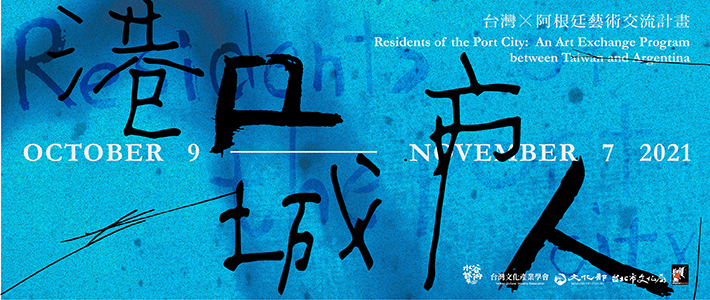港口城市人:台灣與阿根廷藝術交流計畫 Residents of the Port City: An Art Exchange Program between Taiwan and Argentina

主辦人/單位:
水谷藝術
活動類別:
展覽
首次展演日期:
2021-10-09
結束展演日期:
2021-11-07
詳細時間說明:
週一至週日12:00-19:30,國定假日公休。
活動地點:水谷藝術Waley Art
地址:台北市萬華區萬大路322巷6號
關於展演:▍台灣發表
展期|10/9(六)— 11/7(日)12:00-19:30
地點|水谷藝術(台北市萬華區萬大路322巷6號)
地點|水谷藝術(台北市萬華區萬大路322巷6號)
台灣錄像展區|汪紹綱(台灣)、紀凱淵(台灣)
VideoBardo拉丁美洲錄像展區|Javier Robledo(阿根廷)、Marisol Bellusci(阿根廷)、Carlos Cruz & Estefanía Diaz(墨西哥)、Josefina Tai(阿根廷)、Luciana Rizzo(阿根廷)
VideoBardo播映單元|Ebba Jahn(德國)、Eta Dahlia(俄羅斯/英國)、Methas Chantawongs(泰國)、Susanne Wiegner(德國)、Verena Stenke & Andrea Pagnes(德國/義大利)
▍阿根廷發表
展期|實體播映11/25(四)—11/28(日),線上播映11/28(一)—12/3(五)
地點|阿根廷聖馬丁文化中心Centro Cultural San Martín及線上
地點|阿根廷聖馬丁文化中心Centro Cultural San Martín及線上
台灣錄像播映單元|汪紹綱、紀凱淵、何彥諺、王煜松、林盈潔、張根耀、洪鈞元、吳天章、陳依純
▍線上座談
時間|10/16(六)17:00-18:30
與談人|水谷藝術總監彭才瑄
藝術家汪紹綱、紀紐約
與談人|水谷藝術總監彭才瑄
藝術家汪紹綱、紀紐約
主辦單位|水谷藝術
合辦單位|台灣文化產業學會
交流單位|阿根廷Videobardo國際影像詩歌節
VideoBardo策展人|Marisol Bellusci、Javier Robledo
贊助單位|文化部
計畫總監|彭才瑄
計畫經理|陳美智、謝孟潔
計畫發想|楊雅翔、賴慧珈
視覺設計|林子寧
展務助理|林以寧、林霈楨、邱怡婕
合辦單位|台灣文化產業學會
交流單位|阿根廷Videobardo國際影像詩歌節
VideoBardo策展人|Marisol Bellusci、Javier Robledo
贊助單位|文化部
計畫總監|彭才瑄
計畫經理|陳美智、謝孟潔
計畫發想|楊雅翔、賴慧珈
視覺設計|林子寧
展務助理|林以寧、林霈楨、邱怡婕
※以上於台灣發表之「台灣錄像展區」、「VideoBardo拉丁美洲錄像展區」,以及於阿根廷發表之「台灣錄像播映單元」由文化部贊助展出。
※水谷藝術獲國藝會110年「視覺藝術組織營運補助專案」及台北市政府文化局110年度「營運扶植補助」
▍計畫概念及目標
阿根廷是南美洲第二大國家,國內種族多元,15世紀後,西班牙向海外擴張領土,在拉丁美洲建立長期的征服和殖民統治,引進非洲奴隸貿易作為殖民勞動力,反過來也以種族混血及跨文化融合手段來教化原住民。
移民並未止步於港口,來自歐洲、亞洲及非洲的移民相繼橫越大陸,包含義大利、西班牙、法國和德國的移民,1980年代後華人移民在此落根,形成當地第四大移民族裔。
阿根廷外海靠近福克蘭群島的地方,是南大西洋阿根廷魷魚的最大漁場,阿根廷人本身不吃魷魚,倒是吸引了一群逐魷魚而生活的人們,遠渡來此展開七個月的捕撈生活。台灣在八零年代有一批捕魷移民潮,就算每次魷魚季需要在海上待一整個月,密集又粗重的捕撈與加工活、高昂的投資額,都沒有嚇走這些台灣人。
這些台灣人成為阿根廷的「港口城市人」生活著,如今越來越多的華人往內陸移動,華人移民已經不是初來乍到的生澀者,他們嘗試融入當地生活,說西班牙語,他們的第二代也在此出生。與美國的移民經驗不同,華人的移民並非大規模移民,一直到近年才開始逐漸形成華人移民社區。而華人到阿根廷早期大多從事飯店、小雜貨店等與生活日常相關的商業行為。
水谷藝術所在的萬華加蚋仔,為漢人在台北地區最早開拓的土地。康熙48年(1709年)陳天章等五人組成了「陳賴章墾號」,率領民眾至無主地開墾。繼陳賴章墾號後,閩南泉州移民的勢力開始進入北台灣,首先發展起來的便是艋舺。
據日據民俗學者池田敏雄(1916-1981)指出,當年此地是平埔凱達格蘭族以獨木舟(Mankah)載運番薯等土產與漢人交易之地,漢人便以「蟒葛」或「蟒甲」來表示獨木舟,以「艋舺」來代表番舟聚集之處。萬華地處於大漢溪與新店溪的交會口,清領時期商人來此貿易,慢慢地由小渡口演變成大商港,當地曾有三大碼頭,雖然後來河岸逐漸淤積,大稻埕取代了艋舺,但人們隨著碼頭發展不同的城市輪廓與文化肌理。
「港口城市人」做為雙邊交流的概念,與VideoBardo相互推舉藝術家,針對計畫主題回應及討論,並舉辨雙邊實體及線上成果發表,以各自關懷的議題開展,進而在雙邊進行不同的社區交流與行動。透過長期的交流與合作計畫裡,得以建立夥伴網絡關係。
▍Concepts
Argentina, the second largest country in South America, is ethnically diverse. After the 15th century as a consequence of the overseas expansion of the Spanish crown, a long process of conquest and colonization was established in Latin America that also made use of the slave trade from Africa, in turn seeking to catechize the indigenous peoples by generating different crossbreeds and transculturations.
From the port, the migrations did not stop. Europeans, Asians and Africans have
successively migrated between continents. Italians, Spanish, French, Germans and after 1980 the Chinese established themselves as the fourth largest ethnic group of immigrants in Argentina.
successively migrated between continents. Italians, Spanish, French, Germans and after 1980 the Chinese established themselves as the fourth largest ethnic group of immigrants in Argentina.
The offshore area of Argentina, which is close to the Falkland Islands, is the largest fishing ground of Argentine shortfin squid in the South Atlantic Ocean. That Argentines don’t eat squid makes people who make living on squids come here from miles away to start their 7 months of squid catching lives. In 1980s, there was a wave of squid catching immigrants from Taiwan. Even they were required to stay at sea for a whole month every squid season, those Taiwanese were not scared away. Neither were they frighten off by intensive, heavy fishing and processing work, nor the huge amount of investment.
Those Taiwanese have become and are living as “residents of the port city” in Argentina. Nowadays, more and more Ethnic Chinese immigrants are moving inland. They are no longer newcomers. They try to fit in local life style, speak Spanish, and also raise their next generations. Unlike the immigration experience in the United States, Ethnic Chinese immigrants didn’t move to Argentina in large number, and only recently they have gradually formed their own community. Most of the ethnic Chinese immigrants in the early days engaged in business activities related to daily life, such as restaurants or small grocery stores.
Wan Hua, also known by its old name of Galaya, is the place where Waley Art located, and was the earliest land for Han Chinese to reclaim in Taipei. In the 48th year of KangXi, Qing Dynasty (1709 A.D.), the "Chen Lai Chang ", which was applied for by Chen, Tien Chang as the landlord, led people to cultivate the land with no owner. After the reclamation of "Chen Lai Chang" in Taipei, the Hoklo Quanzhou immigrants from southern Fujian started to expand their boundary to the northern Taiwan.
The first developed area was Mangkah, where the Ketagalan people, the Indigenous people, carried their local products, such as sweet potatoes by Mankah (canoe) to trade with the Han people. Mankah, in Han people’s language, represents the place gathered with many indigenous canoes. Locates at the intersection of Dahan River and Xindian River, Wanhua was the place where merchants came and traded here during Qing Dynasty. The pier gradually became a large commercial port, in which there were three major docks. Although the river bank gradually silted up and Mangkah was replaced by Dadaocheng, people have developed different urban contours and cultural textures following the history of the docks.
Following the concept of this bilateral art exchange program, VideoBardo and Waley Art provide a platform for artists to carry out virtual exchange and presentation. The artists develop the topics they focus on, and accomplish different community exchanges and actions on both sides. Through this long-term exchange program, the partnership between Taiwan and Argentina is established.
費用說明:
免費
活動聯絡電話: 02-23011821 活動聯絡人: 水谷藝術







